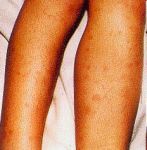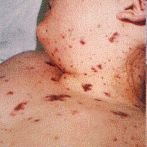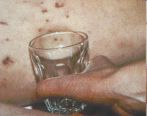Bacterial Meningitis/Meningococcal Disease
Invasive meningococcal disease is the most common form of bacterial meningitis in Ireland, causing up to 90% of the cases. This disease may present as meningitis, septicaemia (blood poisoning) or both.
What is meningitis?
Meningitis is an inflammation of the meninges, which is the name given to the covering layer of the brain and spinal cord.
What is septicaemia?
Septicaemia is a form of blood poisoning caused by the same organism that causes meningitis.
What causes invasive meningococcal disease?
Neisseria meningitidis is the name of the bacteria that is responsible. There are several different types of Neisseria meningitidis, these include groups A, B, C, W135 and Y. Group B and Group C are the most common forms seen in Ireland.
What are the signs and symptoms?
Visit the Meningitis Now website to see common signs & symptoms of Meningitis & Septicaemia in babies & toddlers, children & teens and adults.
Signs and symptoms of meningitis
- Meningitis and septicaemia often happen together. Symptoms can appear in any order. Some may not appear at all.
- Early symptoms can include; fever, headache, vomiting, diarrhoea, muscle pain, stomach cramps, fever with cold hands and feet
- DO NOT WAIT FOR A RASH. If someone is ill and getting worse, get medical help immediately
Adults and older children
Classical symptoms and signs would include temperature, severe headache, neck stiffness, nausea and/or vomiting, stomach cramps, diarrhoea, dislike of bright lights, drowsiness and joint or muscle pains. The patient may be confused and disoriented or have fitting episodes. Not all of these symptoms may appear.
Babies and infants
Classical symptoms and signs of meningitis such as dislike of bright lights and neck stiffness are uncommon and difficult to determine in infants and small children. Do not underestimate a parental instinct that "something is wrong".
Both adults and babies may have a rash. If bacteria enter the bloodstream, they can release toxins, which can damage the walls of blood vessels causing a leakage of blood under the skin. The appearance of the rash can vary. It may start as tiny blood spots which look like red pin-prick type marks which if untreated can spread to form bruises or blood blisters. Do not wait for a rash to appear. It may be the last sign to appear and it can spread very quickly.
If you see or suspect a rash seek medical attention immediately.
Figure 1 and Figure 2 show examples of the septicaemic rash. Figure 3 shows what is called the tumbler test. If you press a glass tumbler against this rash it will not disappear. You will still be able to see it through the glass.
Figure 1. Figure 2. Figure 3.



(Figures 1,2 and 3 were kindly provided by the Meningitis Research Foundation)
How do you get invasive meningococcal disease?
The bacteria which cause meningococcal meningitis and meningococcal septicaemia are common and can live naturally in the back of the nose and throat. It is spread by respiratory droplets, which are most efficiently generated by coughing, sneezing and mouth kissing. Depending on the age group, up to 1 in 10 people may carry this bacteria. Carriage is uncommon in infancy and early childhood but increases with age. Peak carriage rates may occur in the 15-19 year old group of whom 25% are carriers. Carriage is typically followed by the development of immunity. Only a small minority of carriers will develop meningitis or septicaemia after an incubation period of 2-3 days. Why some people develop meningitis and others don't is not fully known but it is believed that on occasion the bacteria can overcome the body's immune system and cause meningitis and meningococcal septicaemia.
Who is most at risk?
Invasive meningococcal disease may occur at any age but is most common in infancy and early childhood with an additional smaller peak of disease activity in adolescents and young adults. In temperate climates such as Ireland the infection typically shows a seasonal variation with the majority of cases occurring in winter and early spring.
Can invasive meningococcal disease be treated?
The answer is yes. The earlier the diagnosis, the earlier treatment with antibiotics can begin and therefore the greater chance that the person will make a full recovery. Early diagnosis is the key so if you suspect that someone may have meningitis or septicaemia seek medical attention immediately.
Is there a vaccine available for meningococcal meningitis?
When talking about vaccines it is important to remember that there are several different types of Neisseria meningitidis bacteria, including groups A, B, C, W135 and Y with groups B and C being the most common in Ireland.
Group C: The meningococcal group C conjugate vaccine (MenC) was introduced in Ireland in October 2000 into the infant immunisation schedule at 2, 4 and 6 months. The vaccination schedule had been changed a number of times since then. A catch-up programme was also launched at the time offering the vaccine to everyone up to and including 22 years of age. The MenC vaccine has been shown to be safe and is effective, it produces an immune response in young infants and gives long-term immunity against group C meningococcal disease. Prior to the introduction of the MenC vaccine to Ireland, group C accounted for 30-40% of the meningococcal disease cases each year. Following the introduction of the MenC vaccine there was a dramatic decline in the numbers of cases of MenC disease in Ireland.
The MenC vaccine is the vaccine that is given to household and very close contacts of a patient who becomes ill with group C meningococcal disease. It is this vaccine that is also used in the control of group C meningococcal disease outbreaks such as schools and military establishments.
In August 2014, the National Immunisation Advisory Committee (NIAC) updated guidance relating to MenC vaccination. NIAC recommended that two doses be given in early childhood (at 4 and 13 months) and an adolescent dose when students are in first year. The booster dose of MenC vaccine for adolescents was recommended based on evidence that vaccine induced immunity to serogroup C (which is provided by early childhood vaccination) may decrease over time. The adolescent vaccination programme commenced in January 2015. Further information on the School programme in 2015 is located here.
In 2016, further changes to the primary immunisation schedule have occurred. For babies born ON or AFTER 1 October 2016 a dose of the Men C vaccine will be given at 6 months and 13 months. Further information on the schedule for children born after this date is available from the HSE National Immunisation Office.
Any child or young adult <23 years of age who never received MenC vaccine should obtain the vaccine from their GP or student health service.
From September 2019, the adolescent booster dose of MenC was replaced with the menACWY vaccine. for further information please refer to the HSE National Immunisation office website.
Note: The MenC vaccine only protects against group C meningococcal disease and does not protect against other forms of the disease such as groups A, B, W135 and Y.
Group B: There has been a marked decline in the number of all meningococcal cases, including those caused by serogroup B reported since 1999. In 1999, out of a total of 536 notifications of all meningococcal disease cases, 292 (54%) were caused by serogroup B. In 2018 (provisional data), out of a total of 89 notifications of all meningococcal disease notifications, 45 (50%) cases were caused by serogroup B.
In January 2013, the European Medicines Agency approved a vaccine which protects against meningococcus group B for sale in Europe. The meningococcal group B vaccine (rDNA, component, adsorbed) which is licensed in Europe is called Bexsero.
In 2016, HSE announced the implementation of the Meningococcal B vaccine programme for all children born on or after the 1st of October 2016. The vaccine is given at 2, 4 and 12 months of age. The vaccine is also recommended for individuals at increased risk of meningococcal disease. Go to immunisation.ie for the most recent national guidance on the use of Bexsero vaccine.
Groups A, W135 or Y: Meningococcal disease caused by serogroup A, W or Y is rare in Ireland. However an increase in serogroup W and Y has been seen in recent years.
The MenACWY vaccine is now recommended for all adolescents in the first year of secondary school. This vaccine replaces the adolescent MenC vaccine that was previously given to this age group. For more information please see the National Immunisation website located here.
Vaccination with the MenACWY vaccine is recommended for those at increased risk due to disease or treatment, close contacts of cases (if not already vaccinated) and for individuals who are travelling to high risk areas (Sub-Saharan Africa and Kingdom of Saudia Arabia- see section on travel -"Meningococcal Disease and Travel"). Click here for further information on National Immunisation Guidance relating to the MenACWY vaccine.
Meningococcal Disease and Travel
Conjugate Meningococcal ACW135Y vaccine (MenACWY): Two conjugate MenACWY vaccines are available in Ireland. The vaccines are made from group A, C, W, and Y capsular polysaccharides. The protein conjugates are either CRM197 (Menveo) or tetanus toxoid (Nimenrix). One to three doses are recommended depending on the age of the individual receiving the vaccine. This vaccine is required for entry to Saudi Arabia during the Hajj and Umrah pilgrimages. Further information on vaccination is available in the WHO publication International Travel and Health.
Individuals travelling to other areas where meningitis outbreaks are reported ("meningitis-belt" Africa) should seek consult with their travel health clinic regarding vaccination prior to travel.
Further information is available from the Immunisation Guidelines for Ireland.
What other bacteria cause meningitis?
Apart from meningococcal meningitis (caused by Neisseria meningitidis) the next most common form of bacterial meningitis is what is called pneumococcal meningitis (caused by Streptococcus pneumoniae). Hib meningitis (caused by Haemophilus influenzae type b) was a major cause of meningitis in infants but has now been almost entirely eliminated following the introduction of Hib vaccine as part of the Childhood Immunisation Programme in 1992.
TB meningitis is a rare form of meningitis. HPSC's Reports on the Epidemiology of Tuberculosis in Ireland provides data on the number of TB meningitis cases notified in Ireland.
Newborn infants are also susceptible to certain types of bacterial meningitis including those caused by Escherichia coli, Listeria monocytogenes and group B streptococcus.
Bacterial meningitis is treated with antibiotics.
How many cases of bacterial meningitis are seen each year in Ireland?
Information on the number of bacterial meningitis cases and deaths notified in Ireland are available on our surveillance data page. Since the MenC vaccine was introduced in October 2000, there has been a dramatic decline in the number of bacterial meningitis cases occurring each year. Information for those affected or bereaved by meningitis is available from www.meningitisnow.org
Reminder: Although the rate of meningococcal disease has decreased in recent years, when disease does occur it causes severe (and sometimes fatal) disease. Therefore, it is important that parents and healthcare professionals are ever vigilant to the signs and symptoms of meningococcal disease.
Last updated: 19 December 2022


